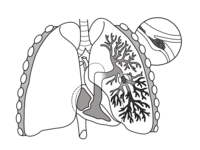
Photo from wikipedia
The aim of this study was to investigate the d-dimer for prediction of venous thromboembolism (VTE) events in puerperium and to identify other risk factors associated with the occurrence of… Click to show full abstract
The aim of this study was to investigate the d-dimer for prediction of venous thromboembolism (VTE) events in puerperium and to identify other risk factors associated with the occurrence of VTE. This was a prospective observational cohort study, which included 16 127 women who gave birth after 28 weeks of gestation at Women’s Hospital of Zhejiang University, School of Medicine, from January 2016 to December 2016. Data including basic maternal and fetal characteristics, pregnancy complications, and predictive biomarkers within postpartum 24 hours including d-dimer, platelet, and fibrinogen were collected for analyses. In the cohort study, 19 (0.12%) women were identified as VTE, including 1 pulmonary embolism event and 18 deep venous thrombosis events. The receiver operating characteristic curve analysis suggested the best cutoff point for d-dimer level within postpartum 24 hours was 3.695 mg/L, with a specificity of 75.5% and a sensitivity of 73.7%, and there was no statistical correlation between fibrinogen and VTE, as well as between platelets and VTE. On multivariate analysis, age ≥35 years (odds ratio [OR] = 2.895, 95% confidence interval [CI]: 1.079-7.773), scarred uterus (OR = 3.894, 95% CI: 1.234-12.282), intrauterine infection (OR = 7.214, 95% CI: 1.519-34.262), antiphospholipid syndrome (OR = 199.530, 95% CI: 15.152-2627.529), d-dimer ≥3.70 mg/L (OR = 7.573, 95% CI: 2.699-21.247), and emergency cesarean delivery (OR = 23.357, 95% CI: 2.819-193.508) were independently associated with VTE in puerperium. We concluded that d-dimer ≥3.70 mg/L was an independent predictor of VTE during puerperium and d-dimer testing was necessary for perinatal women.
Journal Title: Clinical and Applied Thrombosis/Hemostasis
Year Published: 2020
Link to full text (if available)
Share on Social Media: Sign Up to like & get
recommendations!